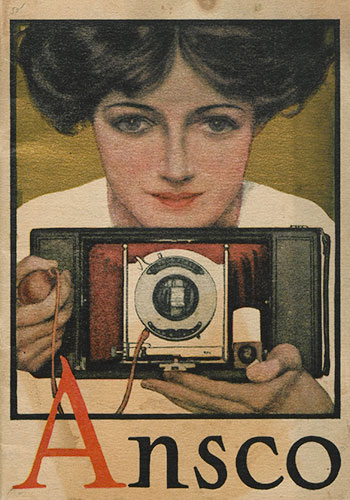Page by Page Guide
My Archive
Register/Log In
Adding Material to My Archive
My Bookshelf
My Lightbox
Documents
Overview and Browsing
Document Details Page
Download Options, Saving, Rotating and Printing
Viewing the Original Image
Share
Searching
Basic Search
Boolean Functionality
Advanced Search
Search Results
Viewing Search Results
Explore
Essays
Industries
Interactive Chronology
Business Biographies
External Links
Search Directories
Galleries
Image Gallery
Trade Card Gallery
Online Exhibitions
Archive Explorer
RefWorks/EndNote
OpenURLs
Getting Started
Before beginning to use Trade Catalogues and the American Home, you may find it helpful to consult the background information contained in the Nature and Scope page found in the Introduction section of this website.
Click on the ![]() icon on the right-hand side of the top banner of every page to link to the relevant section of these help pages.
icon on the right-hand side of the top banner of every page to link to the relevant section of these help pages.
Browsers
Trade Catalogues and the American Home is optimised to use the following browsers: Microsoft Edge, Internet Explorer 10 and 11, and the latest releases of Firefox, Safari and Google Chrome.
My Archive
Click the link in the top right-hand corner to register for 'My Archive' or log in. If you are registering for the first time, enter your details into the form provided. Your first name and last name will be displayed on the site once you have logged in. A link to the privacy policy is included at the bottom of the form.
'My Archive' enables you to register login details and benefit from a range of bespoke features that allow you to create your own personalised collection. Signing up is easy. Just click on the 'Register for My Archive' link on the home page, submit your login details and off you go.
Once you've logged in, you will be able to:
- Save selected documents to 'My Bookshelf.'
- Save any image from the collection to 'My Lightbox'.
- Run a slideshow of your lightbox images.
- Save your search results.
Every document, search result and individual image in Trade Catalogues and the American Home is tagged with the relevant 'Add to My Archive' button. To return to any document without the need to browse or search every time, simply click on the add button and it will automatically be stored in your individual account so you can return to it at any time.
Click the 'My Lightbox' or 'My Archive' links in the top right-hand corner to enter these features.
Once in 'My Archive' you can edit your profile, navigate to 'My Lightbox', view saved searches and documents.
Click on a saved search term to view saved search results. Click on thumbnails in 'My Bookshelf' to view your saved documents.
You can organise the images in 'My Lightbox' at any time by creating a new lightbox. Enter the name of your new lightbox in the box beside 'Create a New Lightbox:' and click 'Create'. Use the tick boxes beside each image to select the images you wish to copy to your new lightbox. In the 'Image Options' menu, click 'Copy selection to another lightbox' to copy the selected images.
You can view your selection of images as a slideshow and export as PDFs by selecting these options from the 'Image Options' menu.
Documents
You can browse the documents in Trade Catalogues and the American Home by clicking on the Documents tab. This will take you to the document landing page. Clicking on one of the Industry thumbnails will return a list of all the documents associate with that Industry. Alternatively, you can click the 'View all Documents' thumbnail to see everything.
You can also browse by selecting a Document Type or Library/Archive from the filters on the left in combination with an Industry. Once you have chosen your browse criteria (e.g. Document Type, Library or Industry) click on an Industry panel if you want to browse documents within that category or List View if you want to browse without a particular Industry.
Once you have a list, you can filter the documents by Date, Document Type, Industry or Library/Archive to widen or narrow your criteria, or view documents. You can view a document by clicking on the thumbnail or title.
Documents are loaded 200 to a page, in alphabetical order by title and can be scrolled through. Navigation between pages with more than 200 documents listed is available at the top of the list. Users can browse previous and next pages, select a page number or a letter from the alphabetical list.
Full text searchable documents are indicated with the following icon: ![]()
From this page you can sort the order of each column and also select the display of the last column to feature either 'Document Type', 'Industry', 'Library', or 'Company'.
From the documents list, click on a title link and this will take you to the document details page that provides thumbnail images from the document, document-level metadata and the ability to start viewing the original image or select some or all of the document to download.
Scroll through thumbnails to select and view images.
Use the 'next' and 'previous' buttons to show the next or previous document details page. Use the back arrow beside the 'next' and 'previous' buttons to return to the document list.
Download the full document or a range of pages as a PDF using the PDF drop-down selection boxes.
Where available, some additional 'Chapter', or 'Visual Highlights' information will also be displayed underneath the metadata.
The Document Type, Brand and Industry, within the metadata are clickable and will generate a search for the same theme across the whole resource. If the document is full text-searchable, any keywords and places will link to the first hit within that document.
From this page you can also add the document to 'My Archive' and, if you have the user rights, you can export the bibliographic details of each document to RefWorks or EndNote citation software.
Download Options, Saving, Rotating and Printing
For the best-quality printout, it is recommended that you download the required image(s) as a PDF. Within the document details and the image-viewing pages you have several printing options. From the document details page you can download the entire contents of the document or specify a page or image range as a PDF document which can then be saved to file or printed. The image or page numbers available will be displayed in a drop-down box. Click on the required image/page to select the range to be downloaded.
When there is a page range provided there are sometimes a number of "unpaginated" images listed at the start of those available to download. These images can also be selected to download as each "unpaginated" listed represents an image. For example, if there are six "unpaginated images" listed and you want to download them all, simply select the first image listed in the drop-down box and then select the sixth unpaginated image listed in the second drop-down box.
From the image view, you can download the current page you are viewing or, where available, specific chapters as a PDF document. Clicking on these options will open a new window for the PDF to download. Please bear in mind when downloading entire documents that many of the files will be quite large and can take some time. You will require Adobe Reader for this facility, which can be downloaded for free by clicking here.
Clicking on the thumbnail, chapter or visual highlight will generate the image-viewing screen. You can increase or decrease the magnification of the original image by using the![]() or
or ![]() symbols in the top left-hand corner of the image-viewer window. To move around the image you can drag the document by holding down the left mouse button and then moving the mouse to the preferred view.
symbols in the top left-hand corner of the image-viewer window. To move around the image you can drag the document by holding down the left mouse button and then moving the mouse to the preferred view.
The ![]() icon will open the image viewer in full screen.
icon will open the image viewer in full screen.
The ![]() icons will rotate the image, which will resize to fit screen view.
icons will rotate the image, which will resize to fit screen view.
The ![]() icon will return the image to its original position.
icon will return the image to its original position.
There are various ways to navigate through a document and you can also download images to print or save. Where available, some printed documents will have additional navigation features such as jumping to the next article or selecting a specific page number.
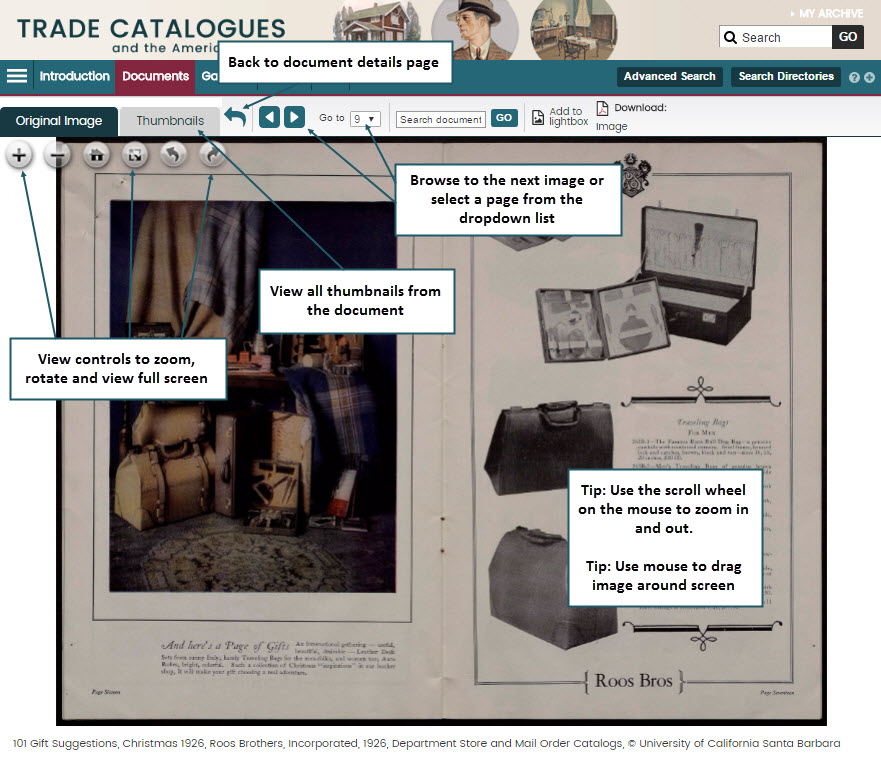
Clicking on the 'Thumbnails' tab will display all the thumbnails for the document.
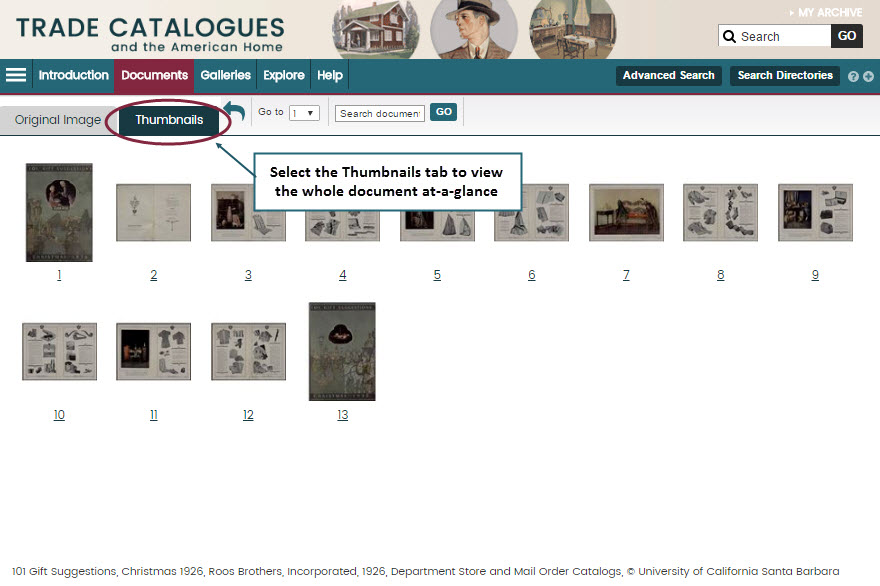
By clicking on the 'Share' ![]() button in the top right-hand corner of the page, you can bookmark and share the page you are viewing via a range of web-based resources and social-networking sites.
button in the top right-hand corner of the page, you can bookmark and share the page you are viewing via a range of web-based resources and social-networking sites.
Searching
The search engine searches across all document-level metadata including bibliographic details, full text of printed material and selected additional editorial features.
Searches are carried out at document level for all documents and also at image level for full text searchable documents.
A basic keyword search box is available on all screens in the top right-hand corner. Type in your search term and either click on 'Go' or press enter. You can also integrate searches with Boolean text for more advanced queries. Underneath the basic search box are links to the 'Advanced Search' option as well as a list of 'Search Directories'.
Boolean Operators
The keyword search supports the Boolean operators AND, OR and AND NOT between keywords. Using the terms Ford and Model T as examples:
To return results in which both Ford and Model T appear, use AND between terms (TIP: The search engine already does this by default – see section on Automatic AND Queries).
To return results which have either Ford or Model T, add OR between terms.
To return results in which Ford, but not Model T appears, add AND NOT between terms. This will search for Ford but exclude any pages which also include Model T.
TIP: You can use either upper or lower case for Boolean terms.
Automatic AND Queries
By default, the search engine only returns results which contain all your keywords. The search engine automatically uses the AND operator, so there is no need to use this when searching for multiple terms.
TIP: To broaden or refine the keyword search, try using fewer or more terms.
Phrase Searching
By adding double quotation marks to your keywords you can search for exact phrases. Words enclosed in quotation marks ("coffee cup") will only return results in which the words appear next to each other. Please note that if you phrase search, your number of hits displayed will still appear as individual words (e.g. if the phrase "coffee cup" appears on a page twice, the results will show four hits).
Wildcards
Wildcards allow you to search for parts of words, enabling you to widen your search criteria. The search engine supports two types of wildcards; "?" represents one character, and "*" represents any number of characters. For example, a search for "consumer*" might retrieve "consumers", "consumerism" etc. You can also use wildcards to search for words as part of a phrase.
Plurals
The search engine does not automatically find plurals of search terms. If you want to look for both "fund" and "funds", use the 'Word Stemming' option under the 'Advanced Search' or the "*" wildcard.
Using Word Proximity Searches
The search engine will let you look for words or phrases that occur within a specified number of words of each other. This is a useful way of specifying the context in which words should occur. For example, a search for "Ford w/10 Model T" may be a more accurate way of finding references to specific details than using a simple "AND" operator, but offers a broader net than that of a phrase search.
Word Stemming
By ticking the 'Word Stemming' option on the 'Advanced Search' page, you can command the search engine to return results on all derivations of your search word(s). Thus a stemming-enabled keyword search for "book" will return book, books, booked, etc. However, it will not return different words that simply begin with book (e.g. bookseller, bookkeeper). For this, you need to use a wildcard.
The Advanced Search page enables you to search for several keywords or phrases using the AND, OR and NOT Boolean operators. Extra fields can be added using the  button.
button.
TIP: Use of these drop-down operators still follows the Boolean rules of precedence.
Searches can be filtered by 'Date', 'Document Type', 'Industry' and 'Library/Archive', by choosing an option from the drop-down lists. Searches can also be refined by images in the Gallery or by Secondary Resources.
Top Searches
Please note that these lists are provided as a starting point for users and are not exhaustive of all metadata or the full text data.
The top ten keywords that have been selected the most by users from the Search Directories lists are displayed in order of popularity on the 'Advanced Search' page.
At the side of the search results page, you can select to filter results by 'Documents', 'Image Gallery' or 'Secondary Resources' only, or refine by 'Date', 'Document Type', 'Industry', 'Place', or 'Library/Archive'.
You can export results as an email.
When you select a document from the search results list, you will be taken to the document details page, where further details of the result will be displayed.
Full text search results will be displayed with a list of the relevant sections from the original image with additional details of the image number, chapter number and number of hits where relevant.
These results can be reordered on the bases of relevance, pages or number of hits.
To view the full document metadata click on the 'Show Details' button at the top of the page. If there is a hit from the document-level metadata, then this will be highlighted.
TIP: If the document is returned in the search results with no full text hits, the metadata will be opened automatically.
You can view the relevant image from the full text search results by selecting the link above the original image snippet (see above). You can view the document from the beginning by clicking on the thumbnail image.
Full text hits are highlighted in yellow on the original image.
Use the 'prev hit' and 'next hit' buttons above the image to browse other hits within the document.
Selecting to view search results will open the relevant document in the relevant collection in a new window.
Explore
The Explore tab gives you additional research tools and new ways to approach the material in Trade Catalogues and the American Home.
This section provides you with a selection of essays written by leading academics. Many of the essays will include hypertext links to the original documents. Clicking on a link will open a new window and if the link relates to a complete document the user will be taken to the Document Details page from where you can browse the images. To return to the essay simply close or minimise the new window.
TIP: The ![]() icon will generate a printable version of the essay.
icon will generate a printable version of the essay.
TIP: The ![]() icon will generate a PDF version.
icon will generate a PDF version.
All the documents within Trade Catalogues and the American Home have been assigned an industry and this can be used to navigate more quickly to documents related to a specific area of research. A wide range of domestic products feature within this collection. Use the Industries page to view brief definitions of the various industries and the kinds of documents you can expect to find within each.
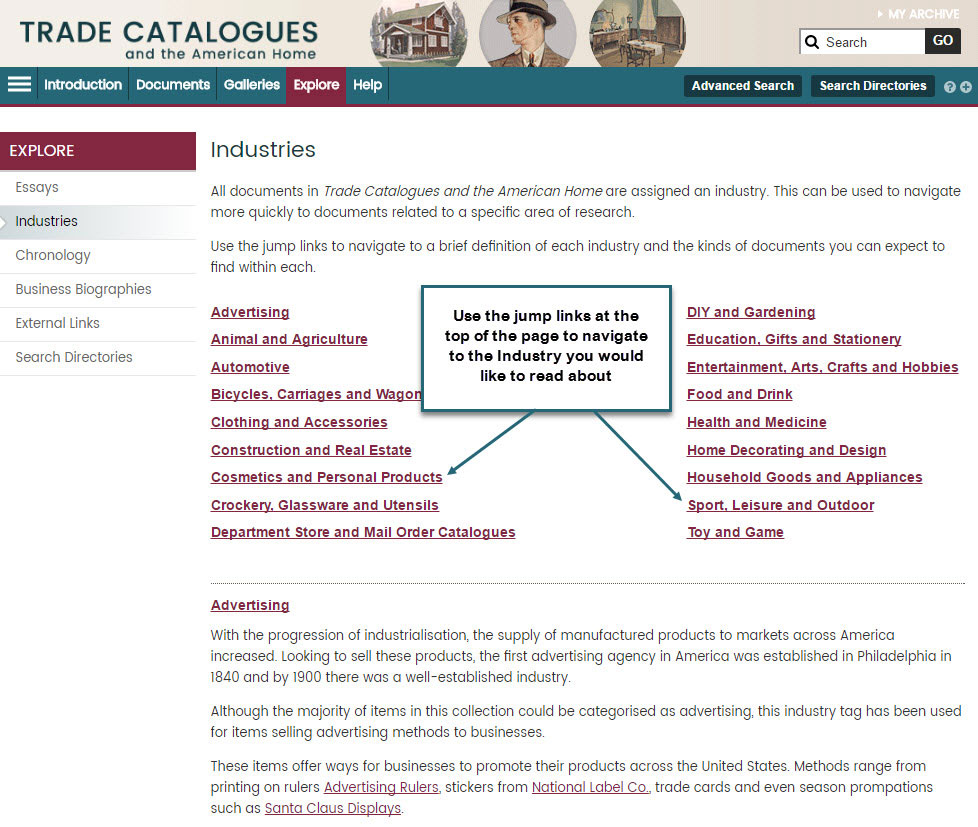
It is also possible to navigate to the Industries page directly from an individual document.
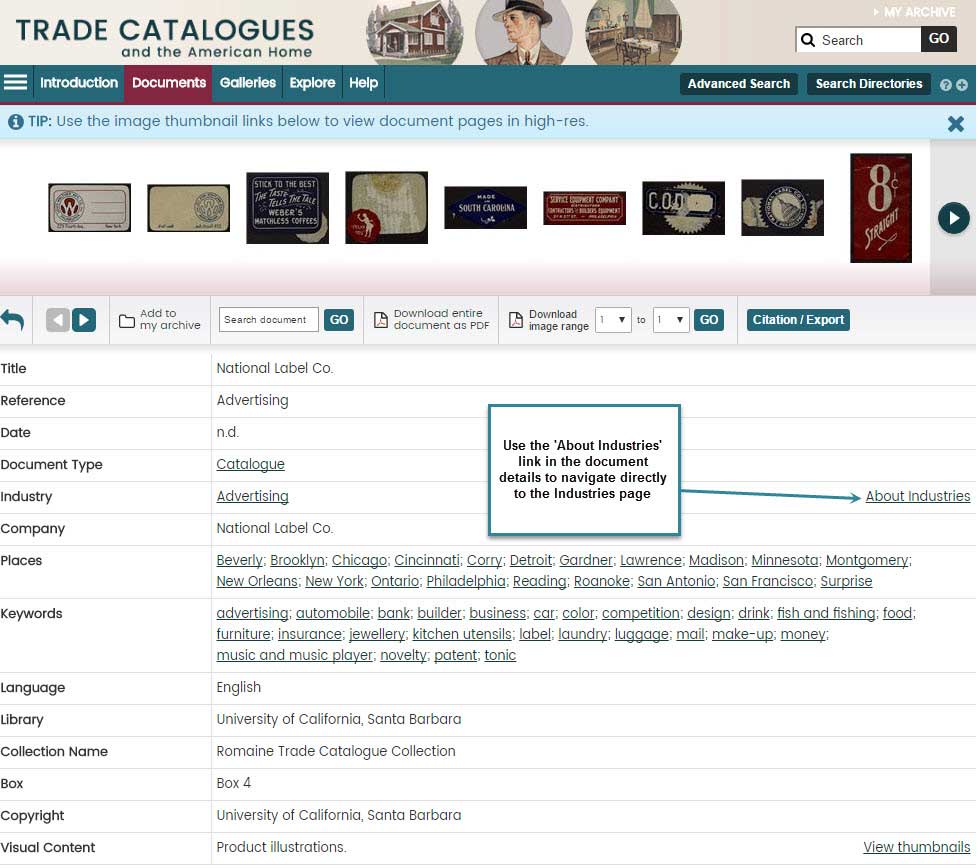
The Interactive Chronology button on the Explore landing page opens a chronology in a new window. Significant moments in the history of consumerism, business, and technology from the mid-nineteenth century to mid-twentieth century can be viewed.
You can search within the chronology by using the simple search box on the left, or by filtering entries by category or demographic.
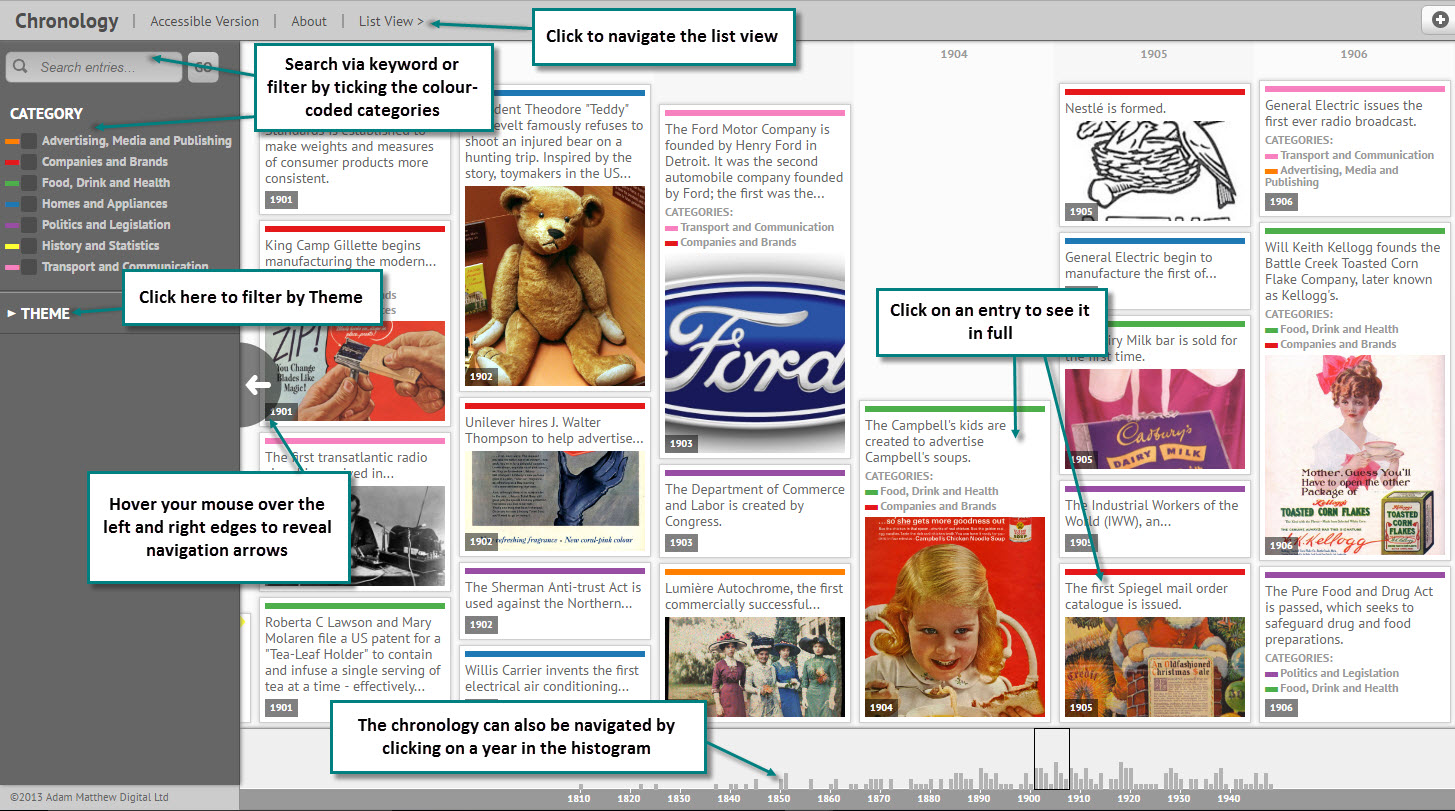
Some entries have images or related documents. Click on the image to expand it or open in full screen view, and click the 'View related documents' button to explore the collection further.
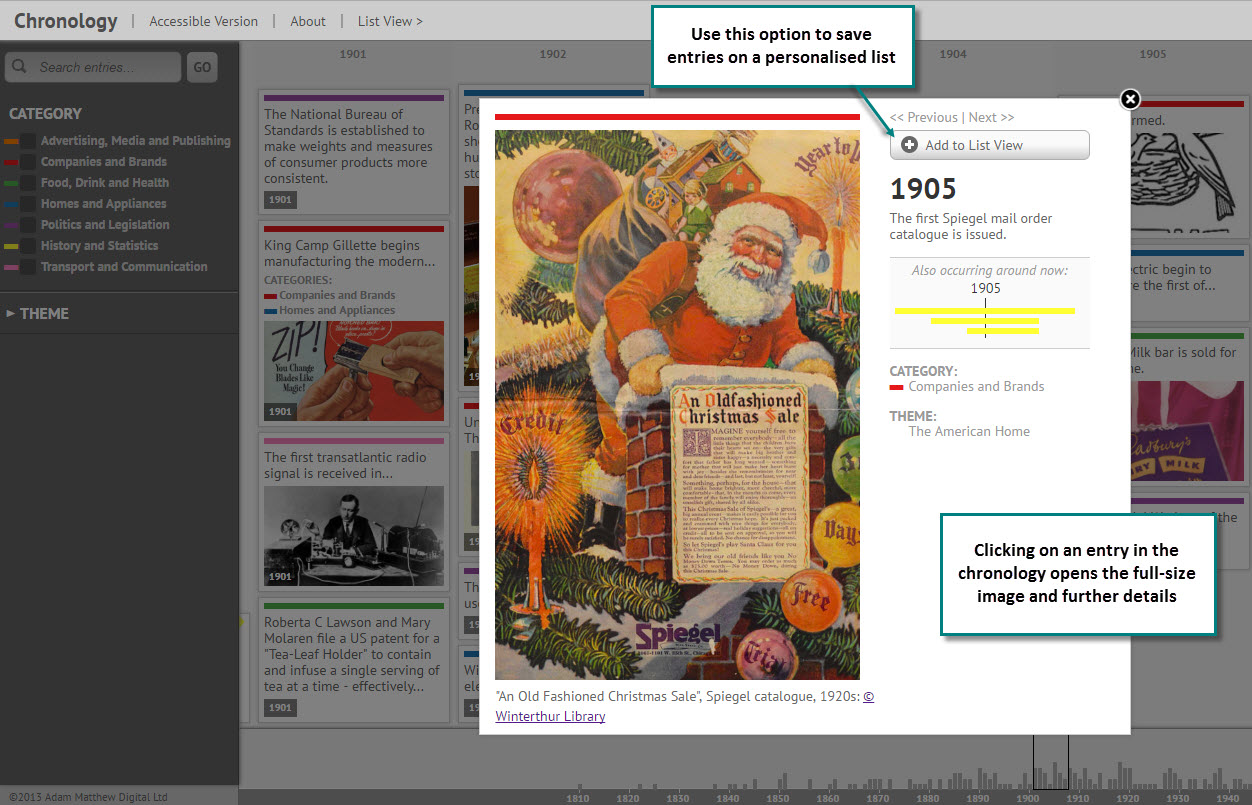
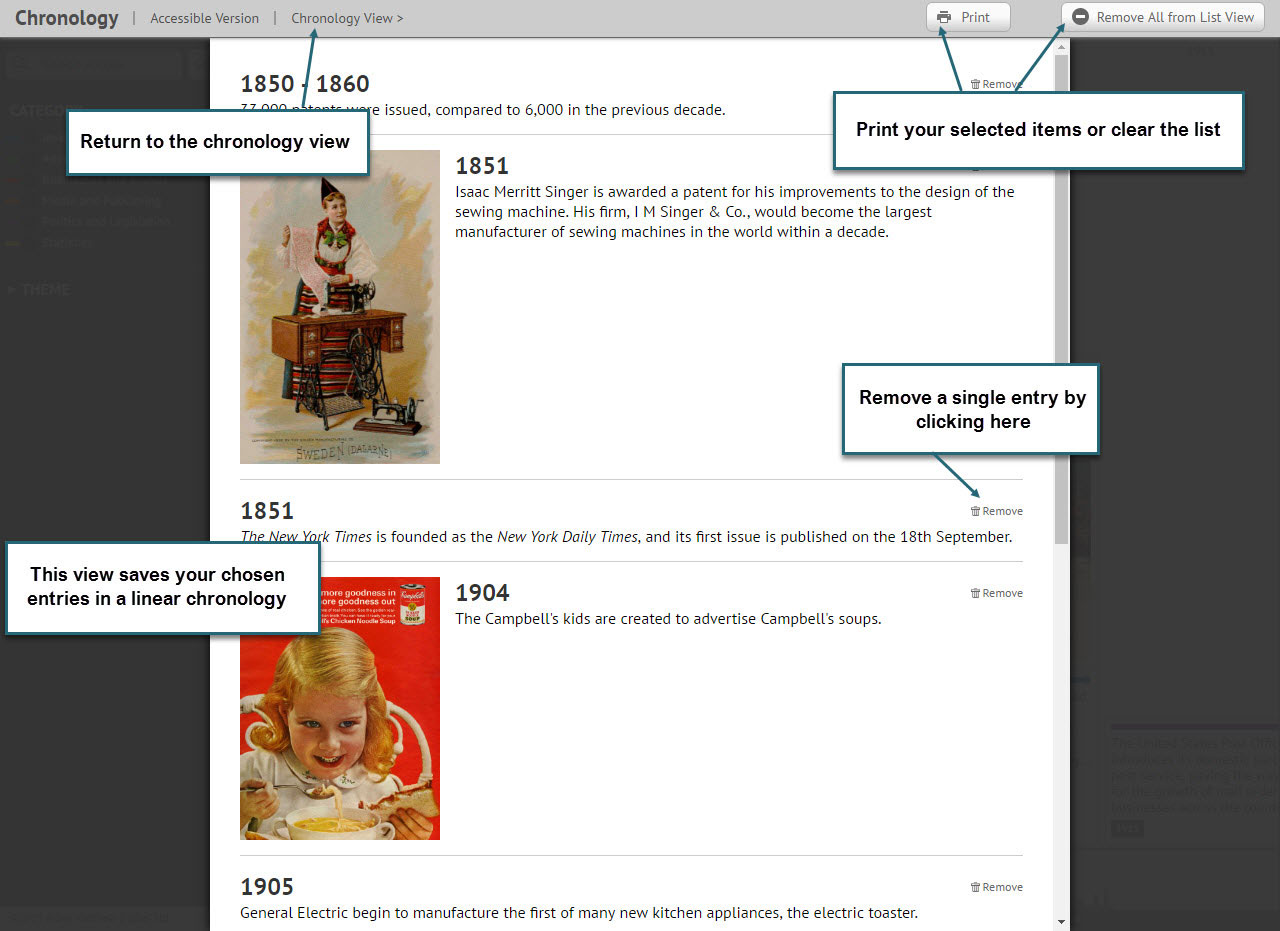
The Business Biographies page showcases some of the most recognised businesses and brands of the nineteenth and twentieth century. Use the letters in the header to navigate these pages alphabetically.
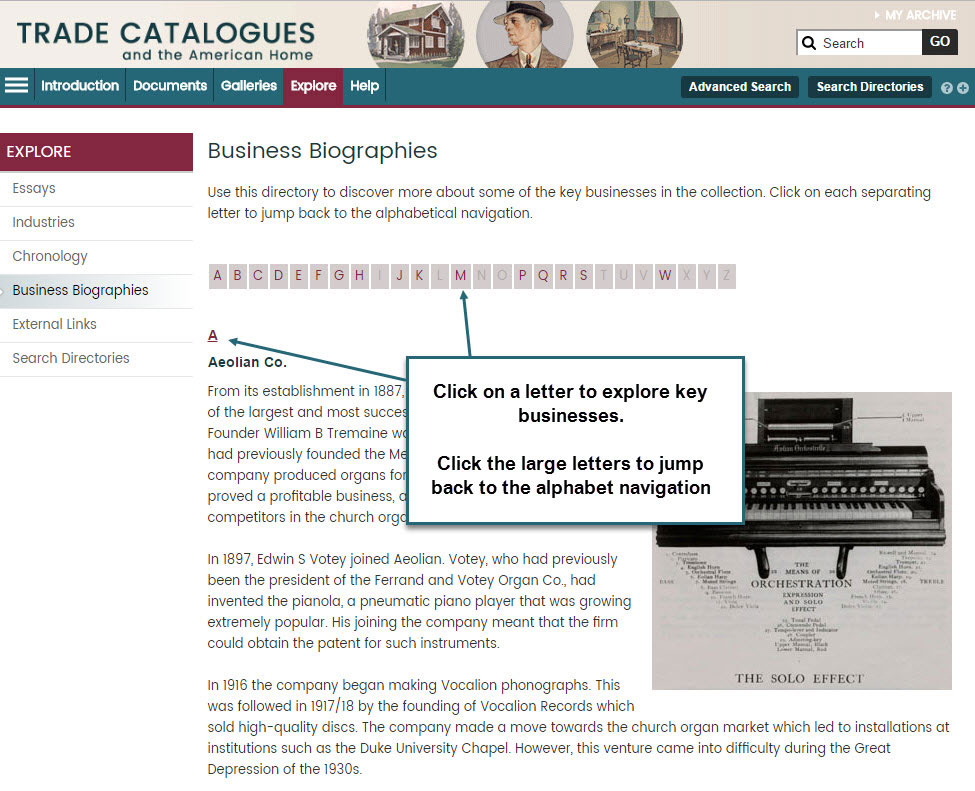
By clicking on this option on the Explore home page, users are provided with a list of websites with important and interesting material on American consumerism, business history, design history etc.
Click on the link in the title of each site and it will open in a new window. Please note that while every effort has been made to provide links to sites created by recognised institutions, Adam Matthew Group is not responsible for their content.
The Search Directories are lists of Keywords (organised by Industry), Brands, Companies and Places, that occur in Trade Catalogues and the American Home. All of this information has been captured where possible, though it is not necessarily a comprehensive list.
To return a list of documents associated with a keyword, simply click on the term you are interested in. You can make multiple selections within one directory. Click 'Search' when you are ready, or 'Clear' to remove your selected terms.
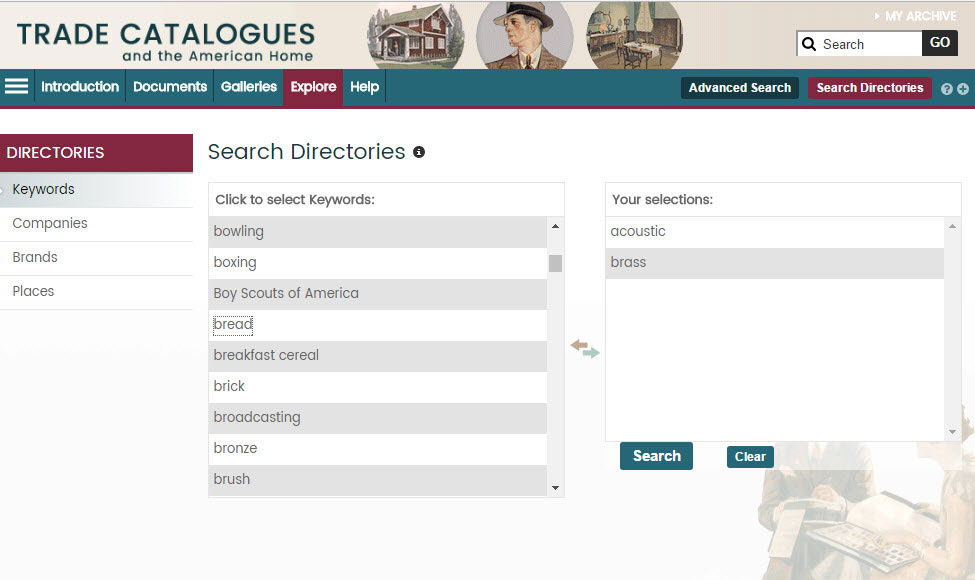
Galleries
The Image Gallery contains selected visual highlights from Trade Catalogues and the American Home.
Gallery images can be filtered by 'Date', 'Industry' or 'Image Type', or there is a search box to help you find what you are looking for.
To view a slideshow of images, select the images you want to use by clicking the tick box next to each title, then select 'Run Slideshow of Selection' from the 'Image Options' drop-down. Alternatively, you can save the selection for this session (click the 'Image Options' drop-down and click 'Add Selection to My Lightbox'), or download the selection as a multi-page PDF.
TIP: The order that you select your images in will be the order that they are played in the slideshow.
To view a full-size version of the image, click on it. You can browse through the images by clicking the 'Next' and 'Previous' buttons, or by using the left and right arrows on your keyboard.
Metadata relating to the slideshow material can be searched in isolation via the 'Image Gallery' search box at the top of the gallery page.
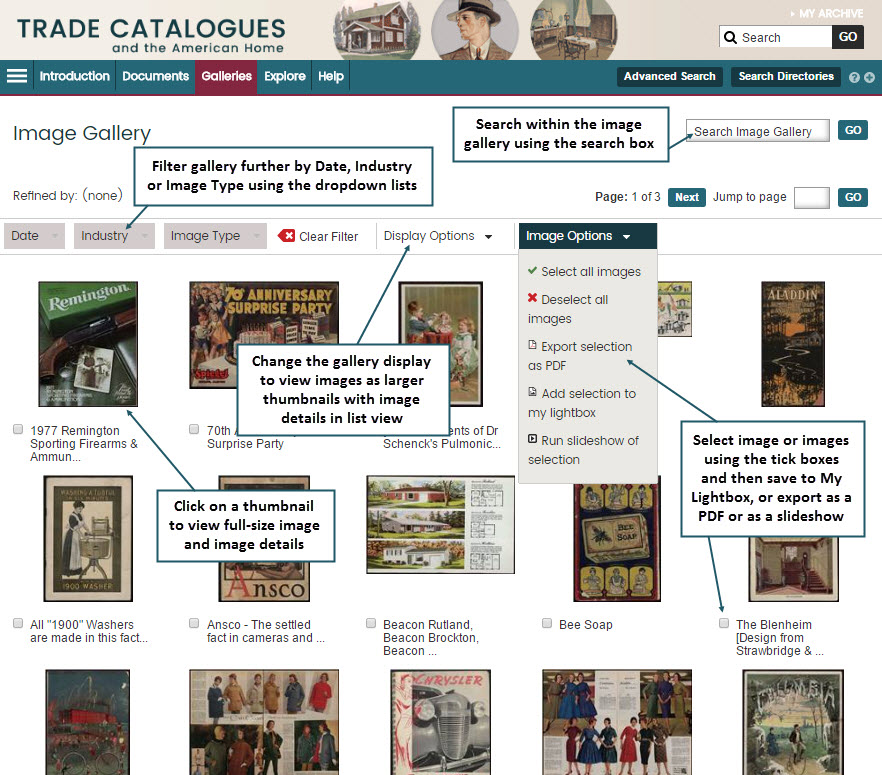
The Trade Card Gallery contains selected visual highlights from Trade Cards featured within Trade Catalogues and the American Home.
Gallery images can be filtered by 'Date', or 'Industry', or there is a search box to help you find what you are looking for.
The Trade Card Gallery functions in the same way as our main Image Gallery.
The online exhibitions highlight the rise of domestic labour-saving technologies. The exhibitions focus on the history and improvements of appliances from 1850-1950.
By clicking on one of the thumbnails, you are taken to that part of the exhibition. Within each section there are image thumbnails which, when clicked, provide different information about each stage in the history of the specific appliance.
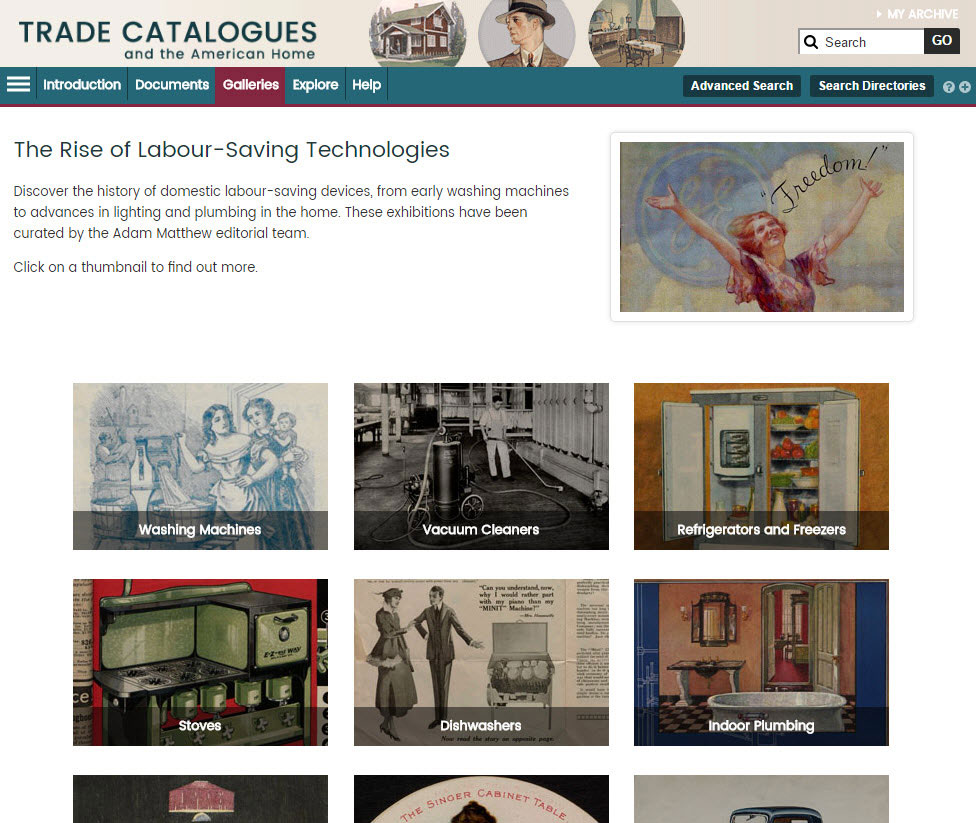
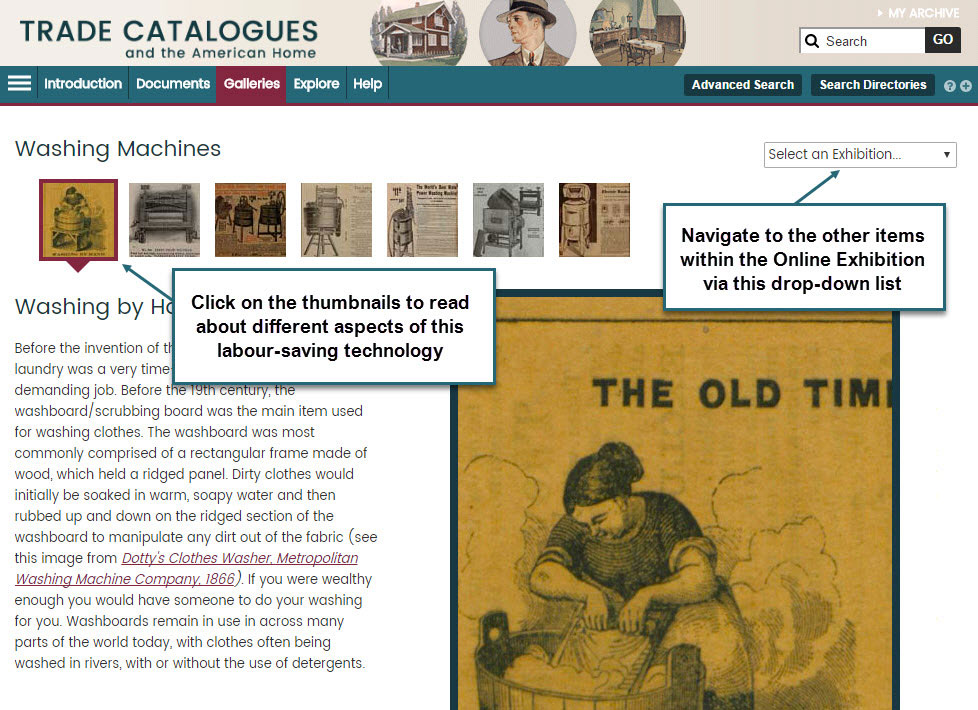
Archive Explorer is a federated searching tool that gives you a quick and convenient way to search across all Adam Matthew collections. You will only be able to access document collections to which your library is subscribed. A link to Archive Explorer is available on the footer of all pages and the Advanced Search page.
You can export the bibliographic details of each document to RefWorks and EndNote if you have user rights to these systems. These options are available to you on the document's listing or on the Document Details page of each individual item. Just click the RefWorks or EndNote logos, and a pop-up window with instructions will appear.
OpenURLs connect you directly to your library catalogue, allowing you to easily access material recommended on this site. You'll find OpenURLs on the essay pages, or anywhere we suggest you continue your research using library materials.
Click on the reference to send this item to your institution's link resolver and establish the easiest way to access this material that is not directly available on this site. Please note that your institution must have registered their link-resolver details with Adam Matthew Digital for the OpenURL links to be visible and active.



